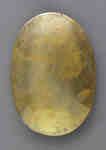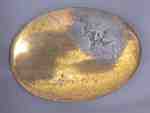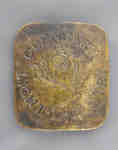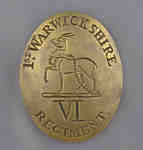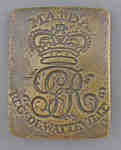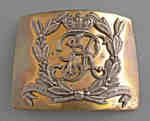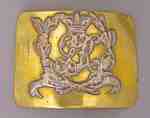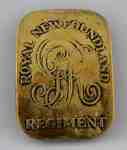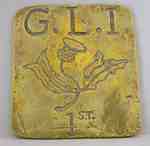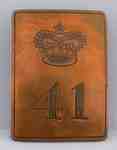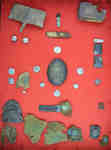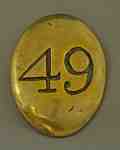Résultats




Page 1 de 1
- This is an oval cross belt plate with no markings on the front and two plugs and a hook on the back. It is believed to from a United States militia during the War of 1812-1814.This is an oval cross belt plate with no markings on the …
- This is a plate that would have been attached to a soldier’s cross belt. It is oval shaped with a rough upper surface. There are no clear markings on the inscribed. The reverse side has two knob-likeThis is a plate that would have been attached to a soldier’s …
- This is a square cross belt plate of the Glengarry Light Infantry, a Canadian Provincial Corps. It has a scotch thistle in the centre with “GLENGARRY LIGHT INFANTRY” inscribed around it. The GlengarrThis is a square cross belt plate of the Glengarry Light Infantry, …
- This is the cross belt plate of the 6th Regiment of Foot (1st Warwickshire). It is oval shaped with “1st. Warwickshire” engraved around the edge. In the centre is an antelope with one foreleg raisedThis is the cross belt plate of the 6th Regiment of Foot …
- This rectangular brass cross belt plate is stamped with a crown and “GR” cipher with an inscription: “MAIDA” (above crown) and “Reg. de. Watteville” (below cipher) This was a regiment of Swiss mercenThis rectangular brass cross belt plate is stamped with a crown and …
- This is an oval cross belt plate from the 1st Battalion of the Canadian Embodied Militia, a Canadian Provincial Corps. The brass cross belt measures 7 cm long and 5.5 cm wide. Inscriptions include “1This is an oval cross belt plate from the 1st Battalion of …
- This is a brass belt buckle that was found in the town of Niagara. It is believed to have belonged to a member of the British light infantry or regular troops because of the lion’s head decoration. FThis is a brass belt buckle that was found in the town …
- This plate is believed to have been used between 1796 and 1828 for a Heavy Cavalry Officers’ waist belt. It is gilt with a silver crest that has “GR” in the centre, with a Hanoverian crown on top, anThis plate is believed to have been used between 1796 and 1828 …
- This is a rectangular brass belt plate with the Hanoverian crown, cipher “GR”, and surrounding garland of laurel leaves in silver. It is a British Light Dragoon regulation issue for an officer in theThis is a rectangular brass belt plate with the Hanoverian crown, cipher …
- This is an oblong, convex brass plate for a soldier’s cross belt from 1803-1812. It is stamped with the cipher “GR” and “Royal Newfoundland Regiment”. This regiment served in Niagara during the War oThis is an oblong, convex brass plate for a soldier’s cross belt …
- This rectangular bass plate is stamped with a crown and “GR” cipher with an inscription: “MAIDA” (above crown) and “Reg. de. Watteville” (below cipher). This item is from a cross belt of a uniform ofThis rectangular bass plate is stamped with a crown and “GR” cipher …
- This brass cross belt plate was fashioned to represent the Glengarry Light Infantry Fencibles. The rectangular plate is stamped with the initials “GLI” and the number one for 1st Battalion. There isThis brass cross belt plate was fashioned to represent the Glengarry Light …
- This brass cross belt plate is stamped "41" and a crown which was created to represent the Forty-first Regiment of Foot, also known as the Welsh Regiment.The first battalion came to Canada from IrelaThis brass cross belt plate is stamped "41" and a crown which …
- These artifacts are mounted on red felt to the back of its case (A). The items are (from left to right): B. A piece of an unidentified metal object that looks like a scraper and two musket balls C. RThese artifacts are mounted on red felt to the back of its …
- This brass cross belt plate is oval shaped and stamped with a "49". This number symbolizes the 49th Regiment of Foot, the Royal Hertfordshires. The 49th Regiment is perhaps the most well known of thoThis brass cross belt plate is oval shaped and stamped with a …
Page 1 de 1

